ISSN ONLINE(2319-8753)PRINT(2347-6710)
ISSN ONLINE(2319-8753)PRINT(2347-6710)
P.SAIRAJ 1, K.PADMANABHAM 2
|
| Related article at Pubmed, Scholar Google |
Visit for more related articles at International Journal of Innovative Research in Science, Engineering and Technology
Steel-concrete composite construction system is an efficient, economical and innovative method for seismic resistance of multi storied buildings. This paper represents a study on economic aspects of G+4 multi storied building designed by using braced frame composite construction. Since ductility, stiffness, inter storied drift and lateral displacements are the critical issues in seismic design of buildings, different types of braced frame models are developed in this study and evaluated its structural performance. Equivalent static method of seismic analysis used in the analysis of geometric models and the results are compared with STRAP software. This study makes an attempt, to develop efficient geometric models for new constructions, and to provide necessary structural configuration against retrofitting of the existing structures, constructed in earthquake prone regions
Keywords |
| Composite construction, seismic zone, ductility, lateral displacement, braced model, Strap software. |
INTRODUCTION |
| Composite structures are reliable and show good performance against stiffness, strength, ductility, and which are the key parameters for design of seismic resistance high raised buildings. Braced frame models are efficient means to transfer lateral forces caused by wind and earthquake. Braced frames are less weight than shear walls, so that it will attract less seismic forces. Braced frames models are proven effective means to enhance ductility of the structure and efficient means to control inter storey drift and lateral displacement of the structure. D.R Panchal et al. [1] , concluded that Steel–concrete composite system perform excellent seismic performance than conventional RCC and Steel Buildings. From Literature review it shows that Braced frame models can also perform excellent seismic resistance in earth quake prone regions. Seyed Hamid Hashemi [2], explained that eccentrically braced frames have high stiffness against the lateral loads such as earthquake and perfect ability to absorb energy. Egor P. Popov et al. [3], provided an overview of seismic resistance eccentrically braced frames with particular emphasis on the behavior and design of shear links. Rafeel Sabelli et al. [4] gave the guide lines on seismic design of steel special concentrically braced frame systems. Due to the truss action generated by the braced frames, the lateral forces are effectively transferred to the foundation with well-defined energy dissipation system .Braced frame action improves seismic characteristics like ductility, stiffness, energy dissipation, and decrease inter-storey drift of the structure. In this context, this paper explains how to develop efficient building models in seismic region. For the purpose of design study, G+4 commercial building selected in seismic zone III in India with wind speed 50m/sec. The plan dimension of the building is 30.5X18.5m with total height 18.75m (each storey height 3.75m) as shown in Table 1& fig 1. Due to constrained architectural requirements, large span column free areas are proposed (10m & 6m span) in both longitudinal and lateral directions of the building. Due to enhanced commercial operations in the structure and to maintain geometric symmetry, separate provisions are made for lift, stair ways, and other accessories and the design scope excluded from the present study. |
II. OBJECTIVE OF STUDY |
| The objective of this study is to develop efficient building models by using combination of CBF & EBF braced frames. Five types of multi storied braced frame models are developed in seismic zone III, and evaluated its structural performance with respect to member strength, ductility and inter storey drift. Equivalent static method used for seismic analysis and the results are verified by STRAP software. The results of all five models are analyzed (Ref Table 2-5) and selected an efficient structural model for design of five storied commercial building. |
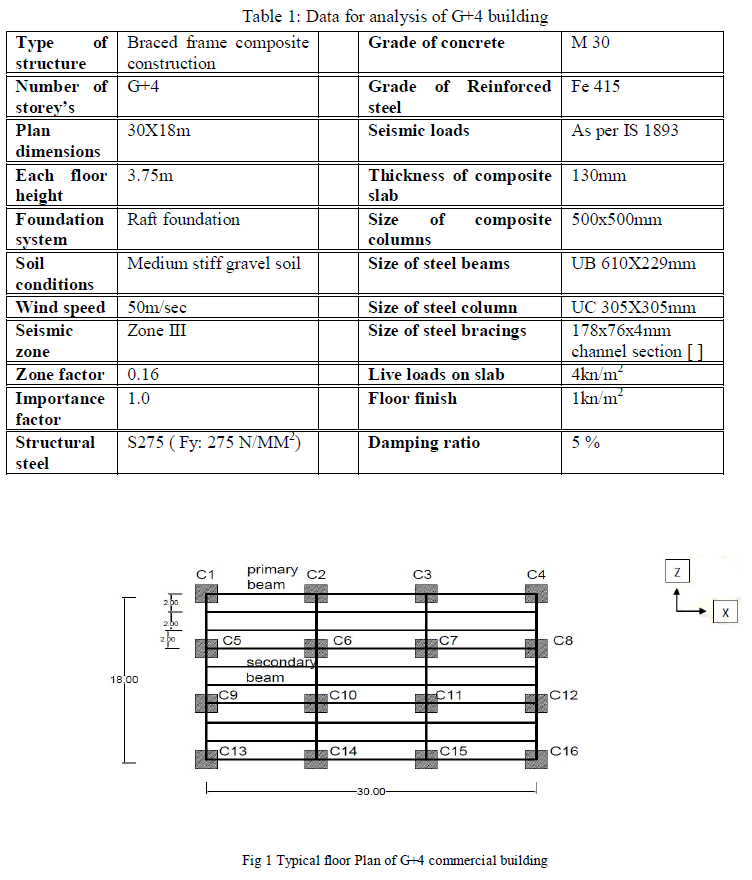 |
| Fig 1: Shows typical floor plan and position of 16 columns represented by C1 to C16 and beams. All the column sections are made with encased steel concrete composite construction. The spacing between the columns are 6m in lateral direction [x direction] and 10m in longitudinal direction [y direction].Beams are divided in to two categories as primary and secondary beams. Primary beams are directly rest on columns with restrained end conditions. Secondary beams are those which are connected to the primary beams by semi rigid connections. Secondary beams are provided with stud type shear connectors to facilitate composite action by floor slab. |
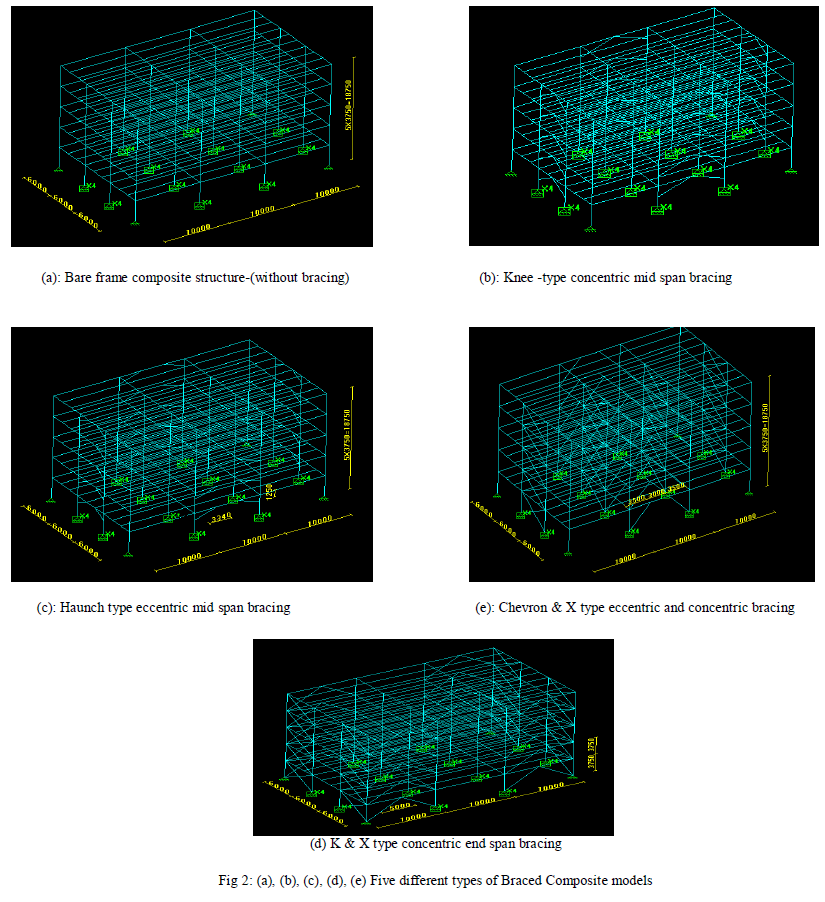 |
III.ANALYSIS |
| Fig 2: Constitute five different types of braced frame models (a, b, c, d, and e) considered in the analysis. Model (a) is a bare frame five storied structure without bracings. Model (b) is a knee type concentric bracing arranged in the mid span of external frame in both X & Z directions. Model (c) is a haunch type eccentric bracing pattern arranged in the mid span of external frame in both X & Z directions. Model (d) is a K & X type concentric bracing pattern respectively, arranged in the end span of external frame in both X & Z directions. Model ( e) is a chevron & X type eccentric and concentric bracing pattern arranged in the end span of external frame in both X & Z directions respectively. The explained five types of building models analyzed by using Equivalent static method and the results are verified by STRAP software. Design parameters such as support reactions, bending moment, shear force, overall deflection, and story drift are verified as per the values presented in Table 3, 4, 5 & 6. |
IV. RESULTS |
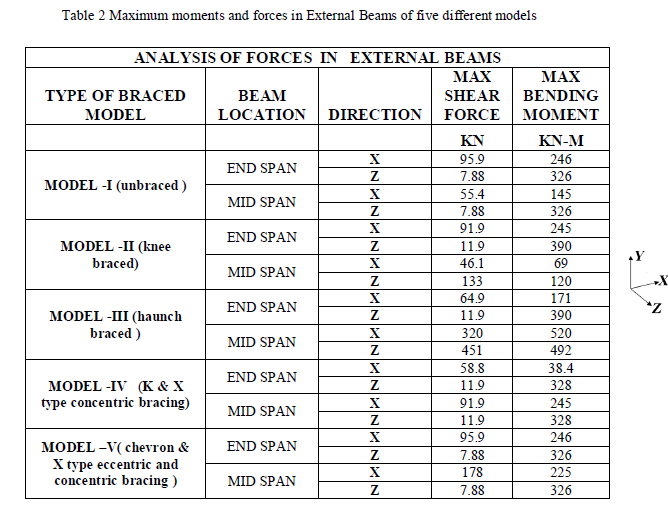 |
| Table 2, Represents the Analysis of forces in external beams for five different braced composite models, the forces which are maximum shear forces and maximum bending moments of end span and mid span of External Beams. |
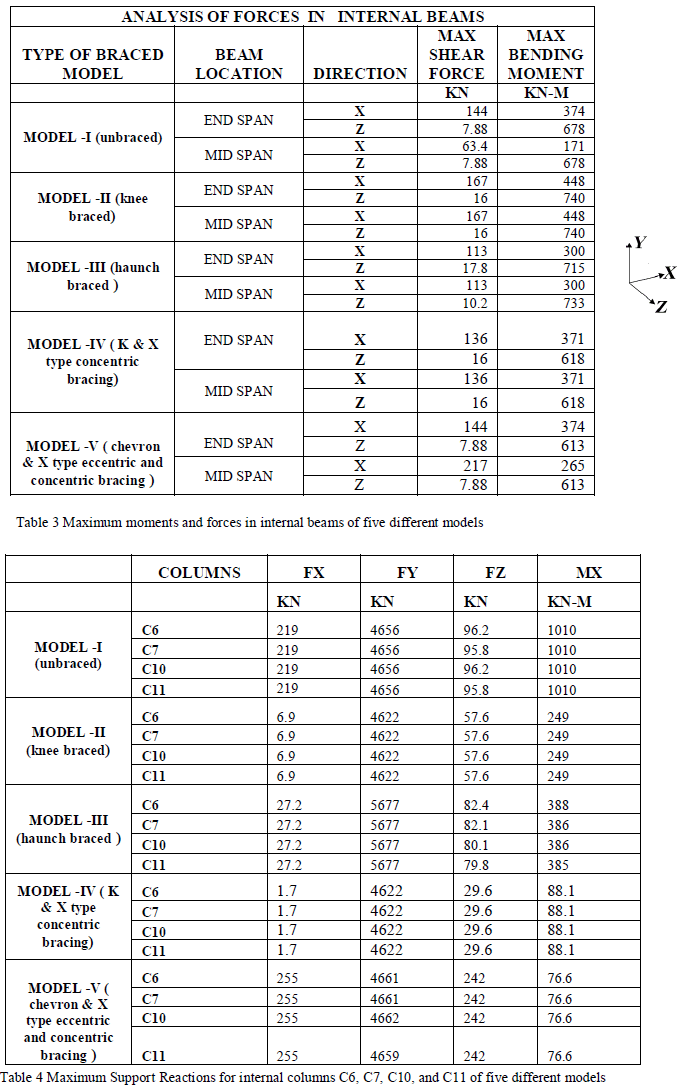 |
| Table 3, Represents the Analysis of forces in internal beams for five different braced composite models, in which maximum shear forces and maximum bending moments of end span and mid span Internal Beams. In model -V (chevron & X type eccentric and concentric bracing) which shows the lesser values than any other models and all sections are safe under Lateral loads and Gravity Loads. Table 4 Represents the Internal Column support reactions, Forces along X, Y, Z directions, which shows FX, FY, FZ and Moments along X-direction, which shows MX are presented. |
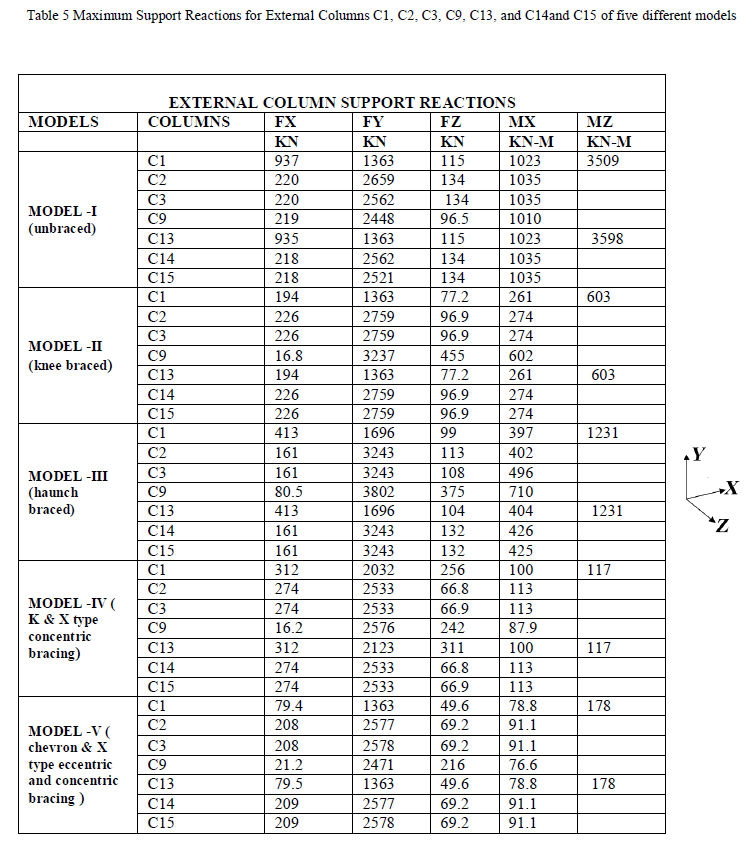 |
| Table 5 Represents the External Column support reactions, Forces along X, Y, Z directions, which shows FX, FY, FZ and Moments along X, Z-direction, which shows MX and MZ are presented. During Analysis all external Column sections are failed except in model 5, because of combination of Eccentric and Concentric bracings are used in modeling of structure in model-5. |
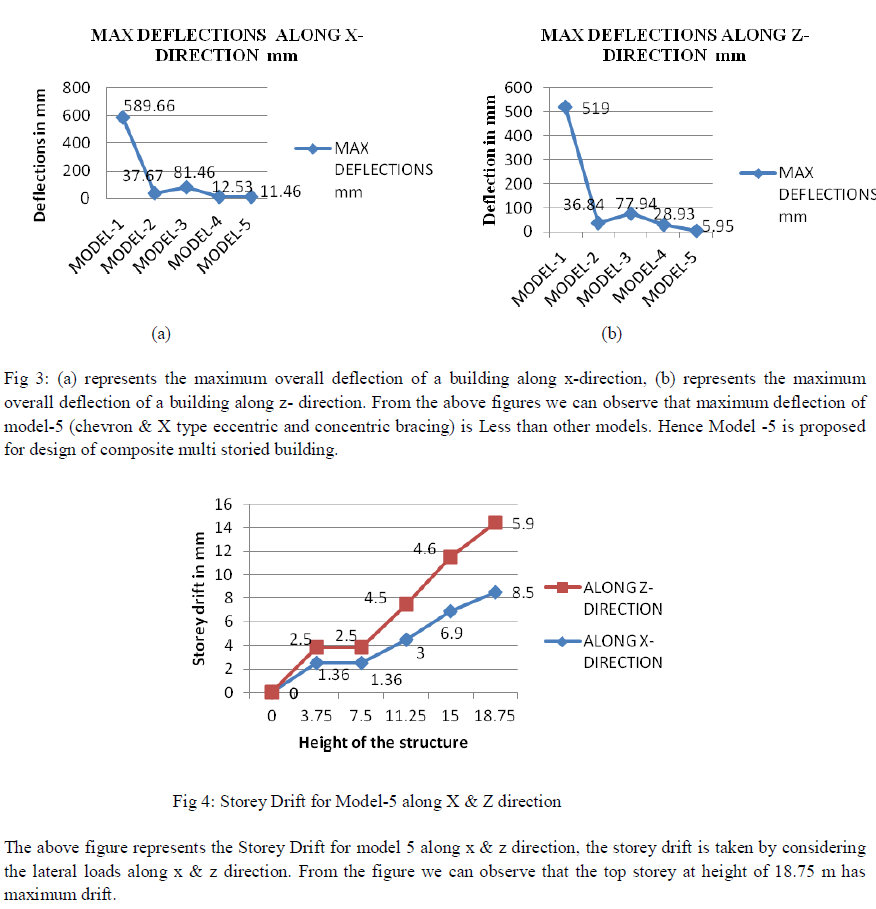 |
V. RESULTS AND DISCUSSIONS |
| 1. Considering overall deflection of the structure, (X & Z directions), bending moments, shear forces in beams and column, model IV is selected from the five trail models. 2. In model – 4, The Lateral Load Resistance System provided by arrangement of Eccentric braced frames (as shown in figure) in both external and internal mid spans (X direction) and Concentric X type braced frames in mid span in both external and internal mid spans ( Z direction.) 3. Due to the truss action formed in the braced frame model, the design may concentrate distribution of seismic lateral loads by bracings and both external, internal walls are exempted to transfer shear loads by other structural members. This consideration helps to avoid soft storey failure in seismic multi storied buildings. 4. Maximum lateral deflections of G+4 multi storied building is limited to X direction 8.5 mm (long span of building) and Z direction 5.95mm( Short span direction of the building) 5. The Maximum inter storey drift between the floors are limited to 1.8mm (X direction) and 1.5mm(Direction), which are less than allowable tolerance limits in buildings. |
VI. CONCLUSIONS |
| 1. Braced frame models are efficient means to show ductile performance of the structure, and they provide effective means of lateral load resistance system. 2. The overall displacement and inter storey drift of the structure can effectively controlled by adopting braced frame models. 3. The designer has versatility to adopt different patterns of braced frames for lateral load resisting system. 4. Braced frames are light weight structure with good strength and stiffness .Due to this reason; these models are less susceptible against seismic forces acting on the structure. 5. Braced composite construction is an effective measure for construction of earth quake resistant multi storied buildings due to the fact that both structural and material performance shows efficient considerations to control seismic forces. 6. Soft storey effect can effectively controlled by braced frame action .This concept is very useful for retrofitting of, and seismic up gradation of the existing multi storied buildings. |
References |
|